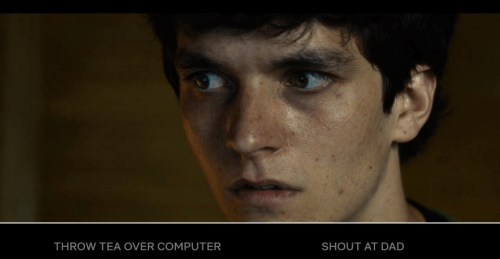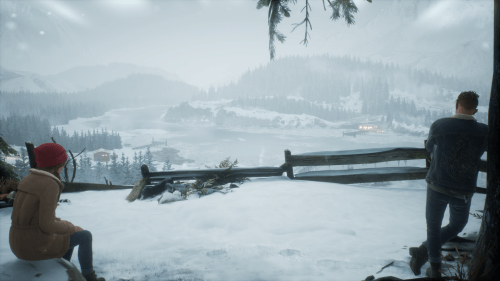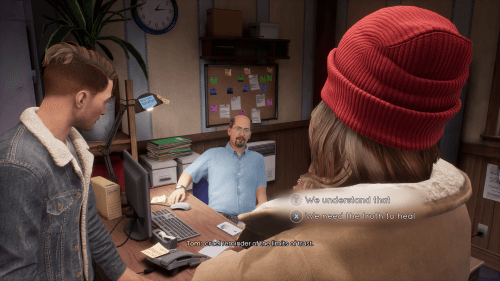My partner and I decided to do a quick co-op play through one of the numerous FMV style games we’ve been seeing all over the Xbox Store for years now. Most of these games (titles like The Bunker and The Infectious Madness of Doctor Dekker) are put out by a publisher called Wales Interactive, though despite similarities, they’re actually developed by a variety of different studios. I guess Wales is trying to corner the market on modern FMV games? Regardless, the one we ended up picking was Late Shift.
Late Shift follows Matt, a 20 something working as an attendant on an overnight shift in a parking garage in London. Almost immediately events on this particular evening lead to Matt being caught up in a criminal plot and, well, to go much more into would spoil things. The story is all, honestly, pretty silly fun. It’s not over the top campy, and the excellent production values lend the whole thing a more serious tone than it probably deserves. That‘s the part where I was pleasantly surprised, actually. The production, direction, acting; they’re all surprisingly good. As a movie it might not win any Academy Awards but as a game? Maybe this comes from playing too many FMVs in the 90s, but I tend to expect a certain amount of grade-a terrible from my FMV games. I mean, that’s the main draw to people going back and replaying them these days, right? On the other hand, Late Shift feels like it actually had a budget. Pfft!

“Things go off the rails in Late Shift quite quickly.”
Another interesting thing about Late Shift (and from what I gather, most of these other Wales FMV games) is that they’re not what a lot of us old timers would think of when we think of FMV games. In the 90s most FMV games were simply games that used copious amounts of embedded video sequences and/or cutscenes, and maybe some digitized spites for good measure. Gameplay wise, while some were games of a distinct genre that got slapped with the label simply for featuring a lot of video, the majority of these games weren’t far off from the classic point and click adventure game formula, though the more they leaned on video the less interactive they tended to be.
Late Shift takes that to the extreme, being something more along the lines of an interactive movie; imagine a Telltale game with nothing but cutscenes and decisions, or Dragon’s Lair with all of the input relating to decisions rather than quick time event like action. This made me think a lot about a similar game I played before Late Shift, but one I never wrote about here due to it being presented as less of a game and more of an interactive movie. Netflix’s surprisingly high profile experiment Black Mirror: Bandersnatch. The idea of an interactive movie played with just a remote isn’t really anything new; there were various similar games released when DVD first started blowing up (including a version of the aforementioned Dragon’s Lair) and I suppose it makes even more sense with modern streaming technology.

“Your average Bandersnatch dilemma.”
Really, Bandersnatch is quite interesting in its own right. It’s about a budding game developer in the days of the UK’s storied early 1980s bedroom programming scene. This is a pretty damn esoteric subject to most Americans, but it’s one I happen to be into so I was sold on the premise alone. As you follow the main character Stefan through being offered a job at a game studio alongside one of his programming idols, Colin, you’re occasionally prompted to make decisions to progress the plot, and believe me this, it goes all over the place. Indeed, Bandersnatch is far from a straightforward experience. Fitting with Black Mirror’s overarching themes of the existential dark side of modern technological advancement, the fourth wall is broken in numerous ways throughout, and the game itself is all too happy to punish you for picking the obvious “right” choices, leading to dead ends and other unsatisfying endings which ultimately encourage or otherwise manipulate you to replay the game multiple times, exploring the branches of its decision tree ad nauseam. In some ways, this reminds me a lot of how old classic adventure games were intended to be played; by sinking endless hours into them to figure out solutions to every puzzle on your own through copious amounts of exploration and trial and error.

“Shit continues to escalate in Late Shift…”
Late Shift is far more traditional in this respect. It doesn’t try to play clever mind games with the player. You’re simply making decisions as presented to you and watching how those choices affect the events of the story until eventually reaching one conclusion or another. There’s no complicated decision structures that need to be charted to be understood, nor any trick options or any other elements of subversive design here. In fact, compare these flowcharts based on the choices for both games: Bandersnatch vs Late Shift. It should be noted that Late Shift features a lot more choices than shown here, though those not represented in this flowchart tend to lead to minor varations in scenes rather than major branches of the plot. Also, try not to pay too much attention to the details, as these charts are absolutely spoiler ridden!
That might sound (and look) like a mark against Late Shift, but to me, this made it a far smoother and overall, more digestible experience. The game is perfectly happy with you playing it once and never touching it again, and none of the endings felt overly abrupt or unsatisfying. If you do feel like playing through it again, choosing radically different decisions as some might do with, again, a Telltale game, the game does provide enough different scenarios and other variations to be satisfying to play through 2 or 3 times. While Bandersnatch may have failed in some respects, I immediately went out and added some of Wales Interactive’s other FMV games to my wishlist upon beating it. I’m just hoping I didn’t spoil myself by trying one of the better quality ones first. I suspect I might have.

“Tell Me Why’s scenery is as chill inducing as it is beautiful.”
Speaking of adventure games, we also played through the next of Dontnod’s games, 2020’s Tell Me Why. Tell Me Why tells the story of two college aged siblings reconnecting to clean up and sell off their childhood home, naturally leading to some tying up of other loose ends concerning their family’s dramatic past. Tell Me Why is also a transgender story, although these elements are handled with a subtly that ultimately makes sure they’re not the focus of the story, despite being pivotal to it. Instead, the most intriguing parts of the story are about our characters’ unusual relationship with their mother, an artist who seemed to embrace fantasy as much as if not more than her children, and as usual with Dontnod games, the compelling setting; this time it’s a picturesque small town in Alaska.
As you might have guessed, this is a much more personal story than any of the Life is Strange games, focusing more on the interpersonal and slice of life aspects of those games. While there are some bigger plot elements, the stakes don’t ever feel quite as high as stopping a serial killer or being on the run from the authorities for a murder you didn’t commit, to use two very specific examples. Part of that has to do with so much of the game being about the past; examining nearly forgotten childhood memories, trying to find answers to questions that had been bouncing around for most of the protagonists’ lives, that sort of thing. The lack of urgency is a bit of a tonal shift, and if, like my partner, you’re the type of person who doesn’t find a lot of value in obsessing on the past, you might even fail to connect to the story entirely like she did.

“Unpacking emotional baggage in Tell Me Why.”
Gameplay-wise, Tell Me Why feels very much like it could be a part of the Life is Strange series, so if you’ve played any of those games then you pretty much know what to expect. Of course, even between games in the LiS series there are numerous mechanical changes, and Tell Me Why is no different. One big one is that the journal is gone, replaced with a book of children’s stories which is occasionally (and rather obtusely) used to solve puzzles. As is always the case in those games, the supernatural power your characters possess is new and different too. And yes, “characters”; you play as both siblings at different parts of the story. A rather huge departure is that I feel like exploration is a bit less of a focus in Tell Me Why. While mechanically it’s just as present as in any of the previous Dontnod adventures, I rarely found any point to it. Descriptions of items were less interesting and insightful, and it was rare to find anything useful in the world. For that reason I didn’t really engage with the collectibles this time around, which is a first for me in these games.
Still, I really enjoyed Tell Me Why, though the particular story and some elements of its storytelling mean it’s less likely to stick with me than any of the previous Life is Strange games. Regardless, after playing this I’m even more curious to check out Dontnod’s next and seemingly least popular adventure game, Twin Mirror. Soon enough, but for now I better get back to Halo Fest…
The Black Mirror: Bandersnatch screenshot above was taken from a random image search result rather than my own Xbox. I found out the hard way that you apparently can’t screenshot the Netflix app. Shenanigans…